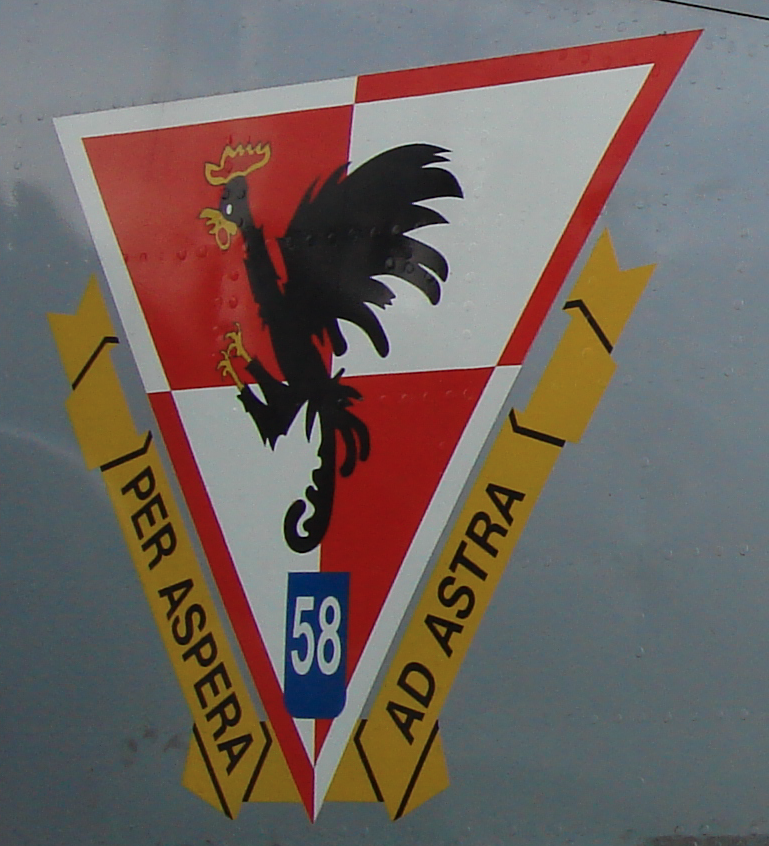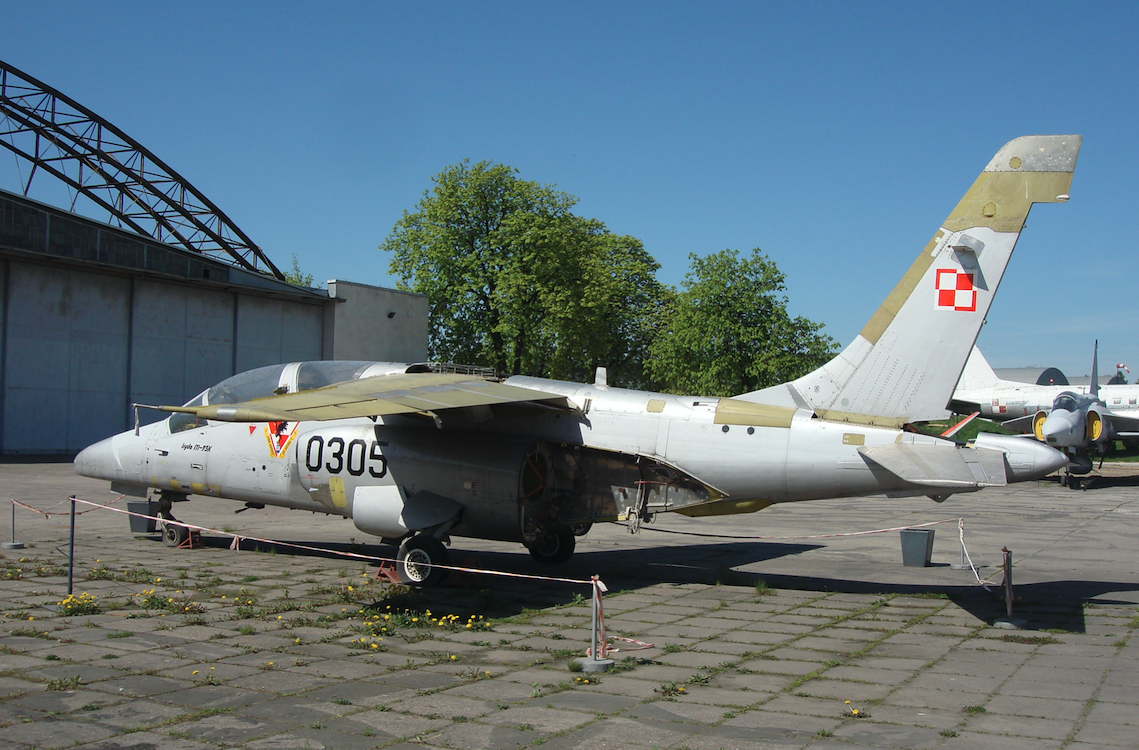Kraków 2011-12-29
58 Training-Combat Aviation Regiment in Dęblin
1958-2000

History
In 1958, a new stage of reorganization of aviation education in Poland began. New, modern equipment required a different, well-developed supply and security system. Under the new assumptions, the cadet during the 3-year training was to obtain a larger raid than before. The officer was to leave the university walls with a total of 215 hours; 115 hours on school aircraft and 100 hours on a combat aircraft.
Therefore, it was decided based on the existing School Squadrons (in two schools in Dęblin and Radom) to create Aviation School Regiments. That is why the Order of the Minister of National Defense No. 075 / org was issued, issued on December 31, 1957. The order ordered, until 15.03.1958, to create School and Training and Combat Regiments on the basis of squadrons. And so as part of:
As part of the School in Dęblin (named after Janek Krasicki);
58 Air Training and Combat Regiment in Dęblin, major pilot Piotr Rojek, aircraft; MiG-15, UTIMiG-15, Lim-1, CS-102.
59 Air Training and Combat Regiment in Biała Podlaska, commander major pilot Edward Sochaj, planes; MiG-15, UTIMiG-15, Lim-1, CS-102.
52 Air School Regiment in Radzyń Podlaski, major pilot commander Stefan Czarnecki, aircraft TS-8 Bies, Jak-11.
23 School Squadron of Navigators in Dęblin, major pilot Grzegorz Winter.
24 School Squadron of Reserve Pilots in Ułęż, commander captain pilot Ryszard Mierzwiński.
25 School Squadron in Podlodzie-Krzewica, commander captain pilot Stanisław Piekara.
As part of the school in Radom (named after Żwirka and Wigura) established;
60 Air Training and Combat Regiment in Radom, major pilot commander Feliks Skrzeczkowski, airplanes; MiG-15, UTI MiG-15, Lim-1, CS-102.
61th Air Training and Combat Regiment in Nowe Miasto nad Pilica, major commander Józef Kowalski, airplanes; MiG-15, UTI MiG-15, Lim-1, CS-102.
63 Air Training and Combat Regiment in Tomaszów Mazowiecki, commander major pilot Kazimierz Ciepiela, MiG-15, UTI MiG-15, Yak-11 aircraft.
64th Air School Regiment in Przasnysz, commander major pilot Bolesław Andrychowski, aircraft TS-8 Bies, Jak-11.
Each of the newly formed regiments consisted of two squadrons, in accordance with 20/452. There were to be 40 pilot-instructors, 40 MiG-15 machines, 18 UTIMiG-15 aircraft and 10 TS-8 Bies aircraft in the aviation training and combat regiment, the production of which was just launched. At the moment, Junak-3 and Jak-11 machines were used for training.
It should be remembered that air combat training regiments in the "W" situation would be second-combat combat units. Most of these regiments were dismantled after a few years. The 58th Air Training and Combat Regiment became a sensation among this type of units and survived until December 31, 2000. Regiment 58 LPSzk-B was all the time associated with the School of Eaglets. From 1957, 58 LPSzk-B operated Lim-1/2 (MiG-15) aircraft.
The regiment has repeatedly participated in various shows and parades, especially in the 1960s. The most important air craftsmanship shows were: The air parade organized on August 16, 1964, over the town of Studzianki Pancerne, on the occasion of the 20th anniversary of the battle fought by the 1st Armored Brigade. Bohaterów Westerplatte. The parade of the 20th anniversary in 1964, in which 36 planes participated in the formation of "herringbone". Air parade in 1966, during the celebration of the Millennium of the Polish State, in which 43 Lim-2 planes participated in the "1000" formation. In 1958, the TS-8 Bies aircraft began to be introduced into the 58 LPSz-B equipment.
In 1964, the first Polish, turbojet-powered training aircraft of the Tadeusz Sołtyk TS-11 Iskra construction was introduced to the equipment of 58 LPSz-B.
In 1979, the Aviation Improvement Center (CDL) was created as part of the Dęblin School. It was a return to the former Aviation Training Center operating at Modlin Airport at the turn of the 50s and 60s. The CDL's task was to improve the qualifications of aviation personnel. Officer's courses of various specialties and levels were organized at CDL. Among others; Higher Training of Officers, Training of Officers, Training of Officers. The equipment equipped with 58 LPSz-B was used.
I have seen pilots from neighboring countries in the school for 70 years. Over 200 pilots from countries such as Syria, Iraq, Libya and Algeria have been trained in Dęblin. These pilots made the majority of their flights under 58 LPSzk. 58 LPSzk in 1981 and 1982, exceeded 9,000 air raids, which was a great achievement. In subsequent years, 8,000 flight hours were always exceeded.
In 1989, the 58th Air Training Regiment was transformed into the 58th Air Training Regiment. The change had no impact on the training system, but the Regiment was no longer expected to be used in the "W" situation. The regiment was equipped with TS-11 Iskra aircraft, of which 66 were in stock (1991). The same number of machines was owned by the sister 60th Air School Regiment based at Radom Airport.
1991 year.
In 1991, the Eagle School had the following subordinate air units;
23 Aviation School Squadron: Dęblin base, 8 An-2 aircraft,
47 School Helicopter Regiment: the base of New Town on the Pilica, helicopters: 46 Mi-2 helicopters,
58 Air Regiment School: Dęblin base, planes: 66 TS-11 planes,
60 Aviation School Regiment: Radom-Sadków homing base, planes: 66 TS-11 planes,
61st Air Training and Battle Regiment: Biała Podlaska base, airplanes: 42 TS-11 airplanes. AND
instructors-pilots from the Aviation School of Combat Regiment organized their own aerobatic team on TS-11 Iskra aircraft. Initially, there were 4 planes, and the team was called Rombik. The band gave their first big show during the Air Show in 1991, at Ławica Airport. The planes then had a new white and red camouflage. Thanks to this, the band received the name Biało-Czerwone Iskry. The band has performed at almost all aviation events in the Republic of Poland as well as abroad.
In the 80's, the Polish Aviation Industry conducted several aircraft projects to serve the Polish Army. One of the constructions was the PZL-130, which was to use pilot piston propulsion similar to turbojet aircraft.
In the second half of the 80s, the Polish Army ordered a short series PZL-130 Orlik, with piston engines and with an option for a total of 25 pieces. The first PZL-130 No. 005 received the AI-14 piston engine. The first flight was on February 19, 1988. However, the Ministry of National Defense abandoned the admission of these aircraft after the attempts. The aircraft received in 1990, a Walter turboprop engine. Designation PZL-130 TM. The aircraft was used for connecting flights in 23 EL (flight squadron) in Dęblin and 45 ELD (experimental flight squadron) in Modlin. The improved Turbo Orlik PZL-130 was introduced in large numbers for the Polish Army. A total of 52 pieces were built.
Over time, all PZL-130 Orlik aircraft from Dęblin were permanently transferred to Radom. The TS-11 Iskra and PZL-130 Orlik aircraft were the last aircraft used in 58 LPSz-B.
The Polish Aviation Industry also conducted a very serious program of another aircraft intended to descend the perfect but already outdated aircraft TS-11 Iskra. Most of those interested placed great hope on Iry 22's program. The aircraft had a great chance to arm the Polish Military Aviation in 1988. However, decision-makers still raised the requirements for this construction. As a result, absurdity occurred, the I-22 aircraft was to match the American F-16. The aircraft developed for WTT from the mid-70s could not meet this.
Exactly on October 24, 1992, the ceremony of symbolic handing over of the first two copies to the army for operation at the Higher Officers' Aviation School in Dęblin took place. Both aircraft were on the record of the 58th Air School Regiment in Dęblin. A few weeks later a third aircraft was delivered. At that time there were I-22 M-91 nb 103, 104, 105 aircraft in Dęblin.

Training on PZL I-22 Iryda aircraft was discontinued in 1994. In 1996, aircraft were withdrawn from the Regiment. Flights in Pułk were still carried out on PZL-130 Orlik and TS-11 Iskra aircraft.
On March 12, 1999, the Republic of Poland joined (together with the Czech Republic and Hungary) the NATO pact. This fact confirmed the political direction towards the USA, towards the Free World.
Although 58 LPSzk invariably belonged to the Eaglets' School, by order of the Chief of the General Staff of the Polish Army No. 083 / Org of 09.08.1999, on 01.01.2000, 58 LPSzk was transformed into 1 Aviation Training Center. Major Pil became his patron. Eugeniusz Horbaszewski. This was to ensure better efficiency in the implementation of the main task of the unit, which for years had been the flight training of cadets.
Commanders of the 58th Airborne Training and Combat Regiment.
ppłk pil. Piotr ROJEK 1958 - 1963
ppłk pil. Zbigniew RÓŻOWICZ 1963 – 1969
płk pil. Janusz KOWALSKI 1969 – 1971
płk pil. Zenobiusz BIENIAŚ 1971 – 1973
płk pil. Stanisław KONOPIŃSKI 1973
ppłk pil. Edmund GORZKOWSKI 1973 – 1976
płk pil. Józef ZDUŃCZYK 1976 – 1979
ppłk pil. Piotr SZAŁAŚNIK 1979 – 1980
ppłk pil. Jan FRYTA 1980 – 1982
płk pil. Krzysztof ŻUK 1982 – 1985
ppłk pil. Andrzej WINIEWSKI 1985 – 1987
płk pil. Maciej NOWACZYK 1987 – 1989.
Written by Karol Placha Hetman
